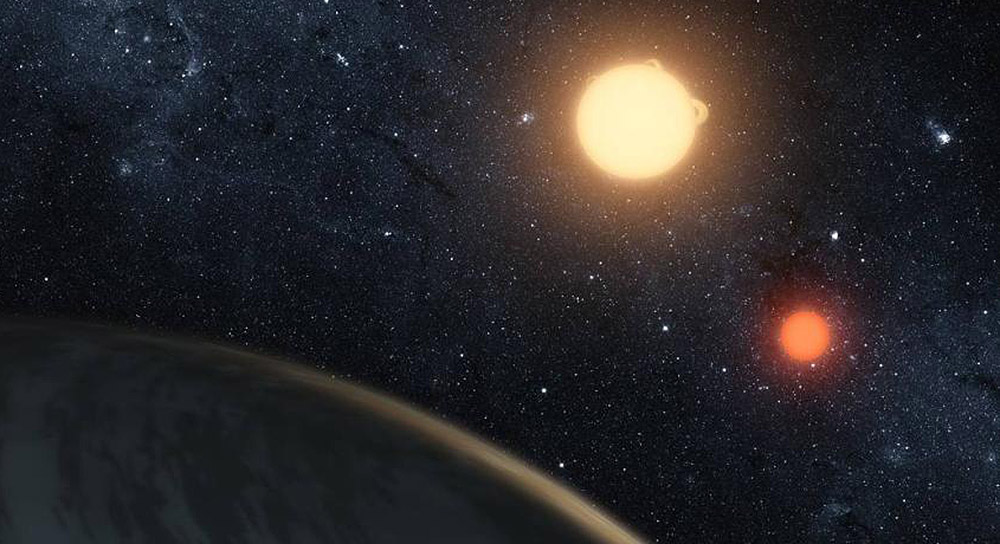Two Suns in the Sky: Exoplanet Kepler-16b, 245 light-years away, orbits two stars simultaneously — similar to Tatooine, Luke Skywalker’s fictional home planet from Star Wars. Now, for the first time, astronomers have succeeded in observing this binary star with a ground-based telescope. This is the first time such a binary planet has been discovered using the radial velocity method – based on the effect of gravity on its stars.
For a long time it was doubtful whether there could be planets around binary stars at all. Because these typically grow in the rotating disk of gas and dust around their star. However, in binary or triple star systems, gravitational perturbation was thought to disrupt this buildup. But the universe refutes this assumption: in 2011, astronomers successfully used Kepler-16b for the first time Circular exoplanets It was discovered – a planet orbiting two original stars. Since then, astronomers have found a number of other exoplanets with two or even three suns Find out, some even go around habitable area their stars.
Why transit notes are not enough
All these two- and three-star planets have been tracked using transits. A planet passing in front of its star absorbs a portion of the star’s light, thus creating a pronounced decrease in the light curve. But the problem is that the transit method can only find planets that, in our view, pass directly in front of their stars. In addition, it does not provide any direct information about the mass of an exoplanet – one of the most important factors for its formation.
As a result, this method provides only a very incomplete picture of how common and diverse circular exoplanets are. This differs with the second method common to planetary hunters: radial velocity. With this, astronomers use slight shifts in the light spectrum to detect the effect of gravity that a planet exerts on its star. This reveals not only mass, but is also independent of the direction of the planets’ orbits.
“Radial velocity is necessary to find more other circular exoplanets,” explain Amaury Triaud of the University of Birmingham and colleagues. “So far, however, no signal from a circular planet has been detected using this method.”
Kepler-16b seen from a spectrophotometer
Now that has changed: Triaud and his team succeeded in discovering the double star planet Kepler-16b through the influence of gravity. To do this, they repeatedly targeted the double star, which is 245 light-years away, using the spectrograph of the 1.93-meter telescope at the observatory in Haute-Provence, France. Using extensive analysis, the team was able to determine the tiny wobble caused by the planet, despite the many chaos caused by the two stars themselves.
The result confirms that the double star Kepler-16 is in fact orbiting a planet. It weighs 0.33 the mass of Jupiter, and is therefore the same weight as Saturn in our solar system. However, unlike the fictional planet Tatooine, Kepler-16b is not a desert planet, but a cold gas giant. With an orbital period of 229 days, it orbits around the outer edge of the habitable zone of its two parent stars. However, from its surface, as on Tatooine, one can see two suns converging in the sky.
The first evidence of gravitational descent
“This is the first time that a circular planet has been detected by radial velocity, as well as the first time that such an exoplanet has been detected by ground-based telescopes,” the astronomers report. They see this as an important first step toward discovering more binary stellar planets using radial velocity.
This may also explain how these circular exoplanets can form despite perturbations in their system. “Planets can form away from their stars and move inward later,” explains co-author David Martin of The Ohio State University. “Instead, we may need to revise our ideas about planet formation by accretion.”
By finding more circular exoplanets, astronomers hope to find some answers to these questions. (Monthly Notices of the Royal Astronomical Society, 2022; doi: 10.1093/mnras/stab3712)
Source: Royal Astronomical Society, University of Birmingham

“Prone to fits of apathy. Zombie ninja. Entrepreneur. Organizer. Evil travel aficionado. Coffee practitioner. Beer lover.”







More Stories
A mysterious discovery on Mars – NASA talks about “tire tracks” or “dragon scales”
Bundesbank chief calls for higher growth rates – MarketScreener
“Dragon scales” or “tire tracks” – NASA spacecraft makes a strange discovery on Mars